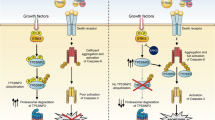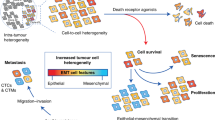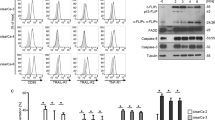Abstract
Tumors have developed several forms of resistance to receptor-induced cell death. Here, we show that malignant mesothelial (MM) cell lines as well as primary MM cells and normal mesothelial (NM) cells express Fas and TNF-related apoptosis-inducing ligand (TRAIL) receptors DR4 and DR5. We found that, although Fas expression levels are comparable, only MM cells are resistant to cell death. Furthermore, MM cells show resistance to TRAIL-induced apoptosis. Caspase-8 (FLICE) is not activated by death receptors triggering in malignant cells whereas it is well activated by nonreceptor stimuli, such as UV radiation. We found that FLIP (FLICE-Inhibitory Protein) is constitutively expressed in all MM cell lines and is more expressed in primary MM cells than in NM cells. Knockdown of FLIP expression in MM cell lines, by a FLIPsiRNA, re-established the normal response to apoptosis induced by Fas or DR4/DR5, which was blocked by pretreatment with the caspase-8 inhibitor z-IETD-fmk. These results indicate that MM cells develop an intrinsic resistance to apoptosis induced by death receptors upregulating the expression of the antiapoptotic protein c-FLIP.
This is a preview of subscription content, access via your institution
Access options
Subscribe to this journal
Receive 50 print issues and online access
$259.00 per year
only $5.18 per issue
Buy this article
- Purchase on Springer Link
- Instant access to full article PDF
Prices may be subject to local taxes which are calculated during checkout






Similar content being viewed by others
References
Attanoos R and Gibbs A . (1997). Histopathology, 30, 403–418.
Bernard D, Quatannens B, Vanderbunder B and Abbadie C . (2001). J. Biol. Chem., 276, 27322–27328.
Bradley M, Zeytun A, Rafi-Janaireh A, Nagarkatti P and Nagarkatti M . (1998). Blood, 11, 4248–4255.
Carbone M, Pass HI, Rizzo P, Marinetti M, Muzio MD, Mew DJY, Levine A and Procopio A . (1994). Oncogene, 9, 1781–1790.
Catalan MP, Subira D, Reyero A, Selgas R, Ortiz-Gonzalez A, Egido J and Ortiz A . (2003). Kidney Int., 64, 321–330.
Djerbi M, Screpanti V, Catrina I, Bogen B, Biberfeld P and Grandien A . (1999). J. Exp. Med., 190, 1025–1032.
French L and Tschopp J . (1999). Nat. Med., 5, 146–147.
French LE and Tschopp J . (2002). Semin. Cancer Biol., 12, 51–55.
Frost P, Ng CP, Belldegrun A and Bonavida B . (1997). Cell. Immunol., 180, 70–83.
Hahne M, Rimoldi D, Schroter M, Romero P, Schreier M, French LE, Schneider S, Bornard T, Fontana A, Lienard D, Cerottini J-C and Tschopp J . (1996). Science, 274, 1363–1366.
Jaklitsch MT, Grondin SC and Sugarbaker DJ . (2001). World J. Surgery, 25, 210–217.
Krueger A, Baumann S, Krammer PH and Kirchoff S . (2001). Mol. Cell. Biol., 21, 8247–8254.
Kumar-Singh S, Weyler J, Martin M, Vermeulen P and Van Marck E . (1999). J. Pathol., 189, 72–78.
Lew F, Tsang P, Holland J, N W, IJ S and JG B . (1986). J. Clin. Immunol., 6, 225–233.
Liu W, Bodle E, Chen JY, Gao M, Rosen GD and Broaddus VC . (2001). Am. J. Respir. Cell Mol. Biol., 25, 111–118.
Manning L, Davis M and Robinson B . (1991). Clin. Exp. Immunol., 83, 85–91.
Medema JP, Tong TJD, Hall Cjv and Melief Offringa R . (1999). J. Exp. Med., 190, 1033–1038.
Mitsiades N, Mitsiades CS, Poulaki V, Anderson KC and Treon SP . (2002). Blood, 99, 2162–2171.
Mutsaers SE . (2002). Respirology, 7, 171–191.
Nagaraju K, Casciola-Rosen L, Rosen A, Thompson C, Loeffler L, Parker T, Danning C, Rochon P, Gillespie J and Plotz P . (2000). J. Immunol., 164, 5459–5465.
Narasimhan SR, Yang L, Gerwin BI and Broaddus VC . (1998). Am. J. Physiol., 275 (Lung Cell. Mol. Physiol.), L165–L171.
O’Connel J, O’Sullivan GC, Collins JK and Shanahan F . (1996). J. Exp. Med., 184, 1075–1082.
Peter ME and Krammer PH . (2003). Cell Death Differ., 10, 26–35.
Plasilova M, Zivny J, Jelinek J, Neuwirtova R, Cermak J, Necas E, Andera L and T S . (2002). Leukemia, 16, 67–73.
Romano M, Catalano A, Nutini M, D’urbano E, Crescenzi C, Claria J, Libner R, Davi G and Procopio A . (2001). FASEB J., 15, 2326–2336.
Roth W, Isenmann S, Nakamura M, Platten M, Wick W, Kleihues P, Bahr M, Ohgaki H, Ashkenazi A and Weller M . (2001). Cancer Res., 61, 2759–2765.
Screpanti V, Wallin R, Ljunggren H-G and Grandien A . (2001). J. Immunol., 167, 2068–2073.
Siegmund D, Hadwiger P, Pfizenmaier K and Vornlocher H-P . (2002). Mol. Med., 8, 725–732.
Stewart JH, Nguyen DM, Chen GA and Schrump DS . (2002). J. Thoracic Cardiovasc. Surg., 123, 295–302.
Strizzi L, Catalano A, Vianale G, Orecchia S, Casalini A, Tassi G, Puntoni R, Mutti L and Procopio A . (2001). J. Pathol., 193, 468–475.
Tepper CG and Seldin MF . (1999). Blood, 94, 1727–1737.
Thomas RK, Kallenborn A, Wickenhauser C, Schultze JL, Draube A, Vockerodt M, Re D, Diehl V and Wolf J . (2002). Am. J. Pathol., 160, 1521–1528.
Tomasetti M, Rippo MR, Moretti S, Alleva R, Andera L, Neuzil J and Procopio A . (2004). Br. J. Cancer, 90, 1644–1653.
Tomek S, Emrl S, Krejcy K and Manegold C . (2003). Br. J. Cancer, 88, 167–174.
Vivo C, Liu W and Broaddus VC . (2003). J. Biol. Chem., 278, 25461–25467.
Wall NR and Shi Y . (2003). The Lancet, 362, 1401–1403.
Wright SC, Zhong J and Larrick JW . (1994). FASEB J., 8, 654–660.
Zang D, Goodwin R, Loken M, Bryant E and Deeg J . (2001). Blood, 98, 3058–3065.
Acknowledgements
This work was supported by grants from the Associazione Italiana per la Ricerca contro il Cancro (AIRC), from the Polytechnic University of Marche Research Fund and from the Italian Department of Scientific Research to AP and MRR and by special Grant DLgs 502/92 from Italian Ministery of Health to MRR. AC is a FIRC fellowship holder. The authors thank Dr Roberto Testi for providing DX2 hybridoma and Dr Michael Freeman for technical assistance.
Author information
Authors and Affiliations
Corresponding author
Rights and permissions
About this article
Cite this article
Rippo, M., Moretti, S., Vescovi, S. et al. FLIP overexpression inhibits death receptor-induced apoptosis in malignant mesothelial cells. Oncogene 23, 7753–7760 (2004). https://doi.org/10.1038/sj.onc.1208051
Received:
Revised:
Accepted:
Published:
Issue Date:
DOI: https://doi.org/10.1038/sj.onc.1208051
Keywords
This article is cited by
-
Ceramide-orchestrated signalling in cancer cells
Nature Reviews Cancer (2013)
-
CK2 controls TRAIL and Fas sensitivity by regulating FLIP levels in endometrial carcinoma cells
Oncogene (2008)
-
Overexpression of cFLIP in head and neck squamous cell carcinoma and its clinicopathologic correlations
Journal of Cancer Research and Clinical Oncology (2008)
-
Human agonistic TRAIL receptor antibodies Mapatumumab and Lexatumumab induce apoptosis in malignant mesothelioma and act synergistically with cisplatin
Molecular Cancer (2007)
-
Characterization of human malignant mesothelioma cell lines orthotopically implanted in the pleural cavity of immunodeficient mice for their ability to grow and form metastasis
BMC Cancer (2006)



